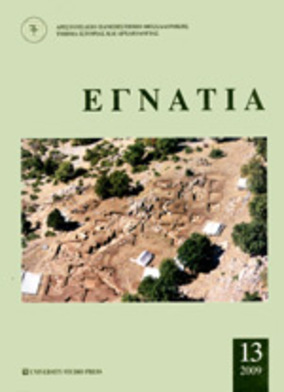Βεργίνα. Η πόλη των Αιγών : συμβολή στην ερμηνεία των αρχαιολογικών ευρημάτων
Part of : Εγνατία ; No.7, 2003, pages 129-163
Issue:
Pages:
129-163
Parallel Title:
Vergina. The city of Aegae
Section Title:
Αρχαιολογία
Author:
Abstract:
The geomorphology of the site of the ancient city in Vergina, on thenorthern slopes of the Pierian mountains, the great structures that wererevealed there, the extensive cemetery that was in use for a long time, therich graves of the archaic and classical period, the characteristic cults and thequality of the finds indicate a unique city with a particular development. Thepalace does not only constitute the main part of the city, but also of thearchaeological research in Vergina. The theater, which was discovered on thenorth and very close to the palace, completes the palace’s picture and itshows the complexity of the functions of the architectural unit. Theinscription to Patroos Hercules, which was found in the tholos, indicates hisimportance concerning the traditional relationship of the area with the familyof the Temenides. Buildings of religious use and statue bases, dedicated bymembers of the royal family according to the inscriptions, were unearthednorth of the palace and the theater. This data permits the identification in thispart of the ancient city of an important part of the town’s agora, which probably includes a wider area than the one known so far. Moreover, in theagora, the worship of Eukleia and Zeus Meilichios was established withcertainty.It is obvious that the most important activities of the state, at least thosethat can be identified by the remaining buildings, are concentrated in the westside of the city. The political center of the town evidently unfolds in thewestern part of the city with the palace and the specific temples of the agora,as a central point of reference to the authority. The presence of many andimportant graves of the 5th and 6th century B.C. nearby, naturally outsidethe city walls, cannot be historically unlinked to the palace and the agora.Although all the known buildings date from the 4th century B.C. onwards,their location, their functions and mainly the cults that can be identified inthis area allow the valid hypothesis that this political-religious center of thecity constitutes the continuation of an older tradition, whose form is not yetknown, but whose presence is suggested by the graves of the 6th and 5thcentury B.C.In the east side of the city, the presence of the sanctuary of the Mother ofGods-Cybele with its intense chthonic character but at the same time laicalmanner, poses many questions as to the origin of the cult and the conditionsof the destruction of the temple around 150 B.C. It appears very possible thatthis important cult played a major role in the creation of the ancient city in Vergina, as its chthonic character and the position of the sanctuary imply Small characteristic portable finds underline, in their own way, the greatimportance and the identity of the ancient town. The seals on the roof-tilesfrom the north city wall and from the Metroon which bear a goat’s head, thegolden coin from Caria found at the tombs of Heuzey and the seal from thepapyrus bearing Hercule’s head discovered in the Metroon, refer —evenindirectly— and each one in its own way, to the ancestral home of theTemenides, the city of Aegae.All of the remarks above regarding the monuments of Vergina, their importance,as well as the useful indications of the small portable archaeologicalfinds obviously add important arguments and convincingly support the identification of the ancient city with the old capital of the Macedonians.
Subject:
Keywords:
πολεοδομία
Notes:
Περιέχει εικόνες




